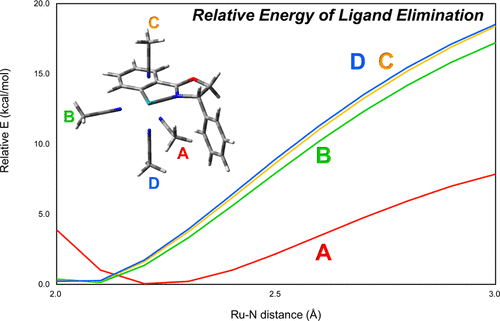Our official English website, www.x-mol.net, welcomes your feedback! (Note: you will need to create a separate account there.)
Ligand Exchange Reaction on a Ru(II)–Pheox Complex as a Mechanistic Study of Catalytic Reactions
ACS Omega ( IF 4.1 ) Pub Date : 2018-09-17 00:00:00 , DOI: 10.1021/acsomega.8b01510 Yoko Nakagawa , Yusuke Imokawa , Ikuhide Fujisawa , Naofumi Nakayama 1 , Hitoshi Goto , Soda Chanthamath , Kazutaka Shibatomi , Seiji Iwasa
ACS Omega ( IF 4.1 ) Pub Date : 2018-09-17 00:00:00 , DOI: 10.1021/acsomega.8b01510 Yoko Nakagawa , Yusuke Imokawa , Ikuhide Fujisawa , Naofumi Nakayama 1 , Hitoshi Goto , Soda Chanthamath , Kazutaka Shibatomi , Seiji Iwasa
Affiliation

|
A ligand exchange of one of the acetonitrile ligands of the (acetonitrile)4Ru(II)–phenyloxazoline complex (Ru(II)–Pheox) by pyridine was demonstrated, and the location of the exchange reaction was examined by density functional theory (DFT) calculations to study the mechanism of its catalytic asymmetric reactions. The acetonitrile was smoothly exchanged with a pyridine to afford the corresponding (pyridine)(acetonitrile)3Ru(II)–Pheox complex with a trans orientation (C–Ru–N(pyridine)) in a quantitative yield, and the complex was analyzed by single-crystal X-ray analysis. DFT calculations indicated that the most eliminable acetonitrile is the trans group, which is consistent with the X-ray analysis. The direction of the ligand exchange is thus determined on the basis of the energy gap of the ligand elimination instead of the stability of the metal complex. These results suggested that a reactant in a Ru–Pheox-catalyzed reaction should approach trans to the C–Ru bond to generate chirality on the Ru center.
中文翻译:

Ru(II)-Pheox配合物上的配体交换反应作为催化反应的机理研究
证明了吡啶对(乙腈)4 Ru(II)-苯基恶唑啉络合物(Ru(II)-Pheox)的乙腈配体的配体交换,并通过密度泛函理论(DFT)检验了交换反应的位置)计算以研究其催化不对称反应的机理。将乙腈与吡啶平稳交换,得到相应的(吡啶)(乙腈)3具有反式取向的Ru(II)-Pheox配合物(C-Ru-N(吡啶))的定量收率,并且通过单晶X射线分析对配合物进行了分析。DFT计算表明,最易消除的乙腈是反式基团,这与X射线分析一致。因此,基于配体消除的能隙而不是金属配合物的稳定性来确定配体交换的方向。这些结果表明,Ru-Pheox催化反应中的反应物应接近反式至C-Ru键,以在Ru中心产生手性。
更新日期:2018-09-17
中文翻译:

Ru(II)-Pheox配合物上的配体交换反应作为催化反应的机理研究
证明了吡啶对(乙腈)4 Ru(II)-苯基恶唑啉络合物(Ru(II)-Pheox)的乙腈配体的配体交换,并通过密度泛函理论(DFT)检验了交换反应的位置)计算以研究其催化不对称反应的机理。将乙腈与吡啶平稳交换,得到相应的(吡啶)(乙腈)3具有反式取向的Ru(II)-Pheox配合物(C-Ru-N(吡啶))的定量收率,并且通过单晶X射线分析对配合物进行了分析。DFT计算表明,最易消除的乙腈是反式基团,这与X射线分析一致。因此,基于配体消除的能隙而不是金属配合物的稳定性来确定配体交换的方向。这些结果表明,Ru-Pheox催化反应中的反应物应接近反式至C-Ru键,以在Ru中心产生手性。



























 京公网安备 11010802027423号
京公网安备 11010802027423号